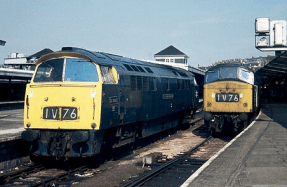

When I consider Devon I think railways, routes west and holidays. This is the way it was before the advent of the car, then later the belief you can only have a holiday if you fly somewhere.
There are curios. Take Exeter St. David’s. Here, we have the odd sight of trains for London heading north and south. It’s a legacy of old railway turf wars when Exeter was home to both the Great Western Railway (trains to London Paddington), and London & South Western Railway or LSWR (trains to London Waterloo). Those rivals created today’s two easterly routes into Exeter, which may be regarded as the Devonian railway hub. The Paddington line approaches Exeter via Tiverton Parkway. The Waterloo line enters the county shortly before Axminster, continuing through delightfully-named towns and villages to the county town.
From Exeter the GWR main line continues to Newton Abbot and Plymouth before exiting the county after St. Budeaux, with the famous Royal Albert Bridge over the Tamar. There are also three other routes that can be taken from Exeter, north west to Barnstaple, south to Torquay and Paignton, and south east to Exmouth. From Plymouth there is also the line to Gunnislake in Cornwall, which is Devonian until after leaving Bere Alston, where trains reverse (this was once part of the Plymouth Devonport & South Western Junction line). This rump survived, whilst the portion from Bere Alston north to Exeter, via Okehampton, closed in 1968.
But there was much more. From Taunton there was another GWR line which snaked its way west to Barnstaple, a town that was a little rail hub of its own, with lines to Ilfracombe (LSWR) and Lynton on the north coast (Lynton & Barnstaple), as well as one south west to Bideford, Torrington and Halwill, where it crossed an east-west route coming from Exeter, via Okehampton, and then, beyond Halwill, continuing to Holsworthy (all LSWR). Bideford also had a separate little line (the Bideford, Westward Ho! & Appledore).

The LSWR main line east of Exeter once had branches down to Sidmouth and Seaton. From Newton Abbot, on the GWR, a train could once be taken to Moretonhampstead in the heart of Dartmoor. Beyond Totnes, at Brent, was a GWR branch down to Kingsbridge, whilst further west, there was another GWR branch heading north to Lydford, with LSWR rails continuing on to Okehampton, and looping back to Exeter (there had long been calls to try and reopen this as an alternative to the coastal main line via Dawlish, which was breached in early 2014, and the first trains between Okehampton and Exeter finally resumed in November 2021). There was also a branch off the GWR line heading north east on to Dartmoor and Princetown. Finally, there was a small GWR branch south east from Plymouth to Yealmpton.
The first main lineTiverton Road which opened in 1844 (Tiverton Junction from 1848) and Cullompton (1844-1964), where there is long-term talk of a new station. There was then Hele (1844-1964), which was ‘Hele and Bradninch’ from 1867, Silverton (1867-1964) and Stoke Canon (1860-1960), which was resited a ¼-mile south in 1894. The line arrived at Exeter St. David’s, which was fairly basic to begin with, so faced an extensive rebuild over 1862-64. That first train into Exeter from Paddington was driven by Daniel Gooch himself, a five-hour haul.




